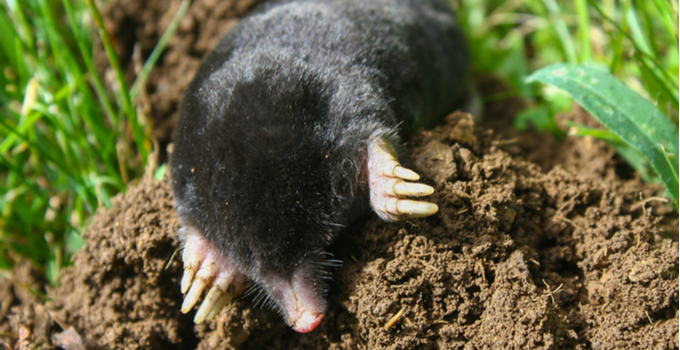Have you ever walked across your lawn to get the morning newspaper, holding a cup of coffee, and tripped on an uneven spot? You look back, and nothing appears to be amiss until you look closer.
Your perfectly groomed lawn is littered with unsightly holes and tunnels. More than likely, you have been visited by a family of moles or voles.
These animals are very similar yet different in many ways. Both love to wreak havoc on your yard, and the best way to get rid of them is with help from an expert.
Behaviors and Appearance
Moles and voles may be hard to differentiate, especially from an untrained eye but here are some notable behaviors and characteristics to watch for.
Moles
- Feeds on insects in the ground
- Creates underground tunnels
- Rarely seen due to being underground most of the time
- Have eyes and ears that are almost too small to see
- Large paws for digging
- Grey, velvety fur
- Sometimes have a strong odor
Voles
- Tiny ears and small eyes
- Looks similar to mice
- Grey or brown in color
- Sharp teeth and flat noses
- Stout body with a short tail
- Reproduces at a very high rate
- Most all are herbivores
Moles and voles alike can cause issues to your home or business any time of year. Moles tend to be most active during the spring, summer, and fall. They will usually be seen tearing through the yard in the early morning or evening.
Voles, commonly known as field mice, can be very active during their mating season, usually in the summer and early fall. They tend to leave their nests up to 20 times per day.
Voles are generally herbivores. Their natural behaviors can cause households and businesses multiple problems. Small trees and bushes are a natural attractant for voles. They love to munch on their limbs and leaves. Their regular feedings can ruin the trees and bushes you have spent valuable funds on. Voles also love eating tree bark.
Moles are carnivores. They burrow their way under your beautifully manicured lawn in search of live insects. They love to snack on worms, grubs, and other small insects. Moles continually search for new sources of bugs to eat. As they search for food, they inadvertently are ruining your lawn with the tunnels they burrow.
Signs of Mole and Vole Infestation
There are a few ways that you can easily identify an infestation of moles or voles on your property.
Mole hills-mounds of soil that are an entrance to a tunnel
Raised soil areas-usually about an inch high and up to four inches wide
Soft areas-burrowed areas made by moles cause your lawn to be weak, and they will sink in when walked over.
Voles love to burrow under the snow in the wintertime. As the snow melts in the early spring, their tunnels become visible. When this happens, voles run to neighboring grasses, mulch, and shrubs to hide from predators.
How to Prevent Mole and Vole Infestations
The best way to keep moles and voles out of your home or business is with prevention. Here are a few tips:
Protect Your Plants
You may want to put your plants inside a cage of hardware cloth. Be sure to protect the roots as well.
Keep Your Yard Tidy
Moles and voles love to hide. They will find a random pile of weeds or yard trash to sneak into. Mow as often as possible and eliminate hiding places.
Use Traps
If you have problems with moles and voles, you may want to consider using a trap. There are many options available. Keep in mind that traps may only be a temporary solution.
Call The Professionals
If your home or business is under attack by moles and voles, it may be time to speak with a professional. The friendly staff at SOS Exterminating are ready to discuss the many possible options you have. Call us today at 480-571-1437.

 480-497-1500
480-497-1500 
